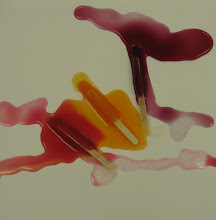
Still from Mircea Cantor
Deeparture, 2005.
Mircea Cantor: Black Box, a space for new media,
Hirshhorn Museum and Sculpture Garden
7th Street & Independence Avenue, SW
September 17-December 9, 2007
Wedged between the slamming of coat room lockers and the swoosh of flushing restroom toilets in the Hirshhorn Museum’s “Black Box” screening room is Mircea Cantor’s approximately seventeen minute, silent video loop of a single deer and a lone wolf in a blank, white-walled space which looks suspiciously like a gallery. Far from static wall décor, these animals are very alive. What does the artist mean for us to observe in what boils down to a highly edited, repeating, four to five minute nature scene? Given the artificial setting, it seems that we are precluded from observing anything ‘natural’ in this habitat. Is it a fable, or a parable then?
The Hirshhorn repeatedly offers in multiple print sources that accompany the exhibition that the title of the work “Deeparture”, according to the artist, is applied to “encourage viewers to use the work as a departure point to look deeper into themselves.” It seems like an attempt at a modern day bestiary- a rewriting of subjective allegorical attributes for the cloven and canine. Like the intricate curlicues of an illuminated, medieval manuscript, teasing meaning out of the repeated vignettes of Cantor’s video requires a cloistered atmosphere, yet this is almost unattainable due to the din of visitor activities occurring around the screening room. Has it come to the point that even in a museum, we must assume that silence is as unattainable as an attention span of more than thirty seconds?
The artist’s decision to include no sound suggests that it is in silence that we should view his work. I tried. It was only after forty-five minutes of intense scrutiny of the picture, approximately twelve to fifteen times (part of which I childishly plugged my ears with my fingers) that the repeated sensing and self-possessed reactions of both animals in the stark and silent space began to hold any level of allegorical influence progressing beyond the dialectic of predator and prey. Kelly Gordon, Associate Curator, instead briefly offers possible subjects like the post communist, dictatorial Romanian nationality of the artist, the environment, instinct, domestication and the contemporary work of other artists that use live animals in the text that is offered as a handout to visitors. On the surface, the decidedly condensed four minutes of Mircea’s “Deeparture” looks like all of the metaphors Gordon names, but a metaphor doesn’t necessitate reflection on a moral or a meaning, like an allegory or bestiary does.
In this story, after pacing back and forth and sniffing the ground, the wolf chooses to lie down and after only a moment closes his eyes to rest. While its eyes are not closed for long, the deer has no such luxury. The deer’s pacing, panting and defecation is so subtle to our human eyes, that it requires the extreme close ups used in film to get these facts across. The deer does not lightly show fear or weakness in this private, artificial hell. Is the artist’s intention to capitalize on the predator/prey relationship after all? The deer, the wolf and the gallery may be metaphors, but nobody gets eaten, or even scratched. Behavior carries the real allegorical weight in this work. The burden of proof is in seeing behaviors that are real, instinct or consciousness notwithstanding. This demands facing a truth that is apparent even in the most elementary diagram of the web of life. Even in a world where very real decisions are carried out in increasingly virtual time and space, we can’t all be wolves.
Karen Joan Topping
9/29/07
Works Cited
Cantor, Mircea. Deeparture. Mircea Cantor and Yvon Lambert, Paris, New York. 2005.
Gordon, Kelly. Black Box, a space for new media: Mircea Cantor. Washington, Smithsonian Museum and Sculpture Garden. 2007.

No comments:
Post a Comment